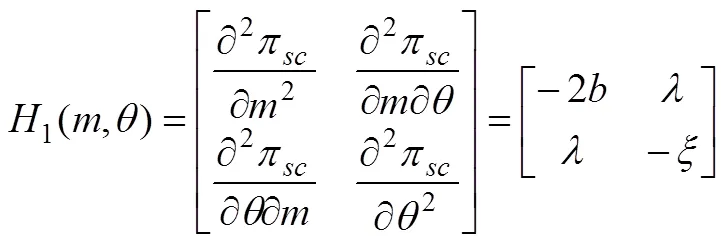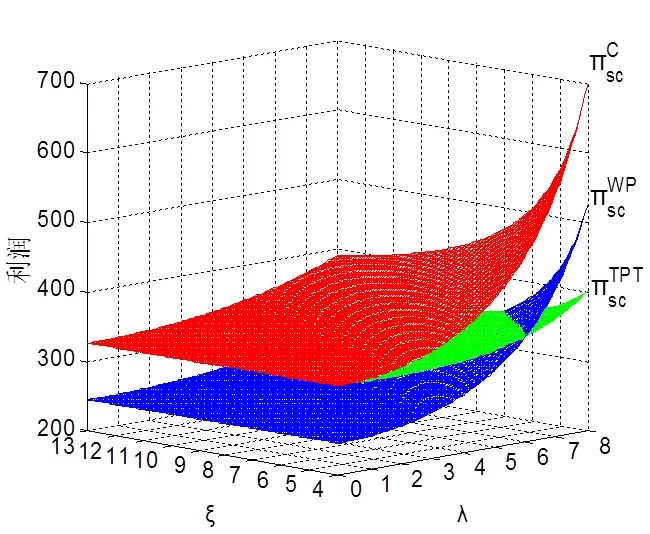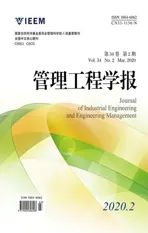零售商主导下促进绿色产品需求的联合研发契约协调研究
2020-04-16周艳菊胡凤英周正龙
周艳菊,胡凤英,周正龙
零售商主导下促进绿色产品需求的联合研发契约协调研究
周艳菊,胡凤英*,周正龙
(中南大学商学院,湖南 长沙 410012)
针对绿色环保产品价格过高,阻碍其成为主流消费品这一现实问题,在绿色经济背景下,探讨零售商向负责绿色研发成本投入的制造商提供不同联合研发契约时的供应链均衡策略和协调问题。以零售商主导的双边垄断型绿色供应链为研究对象,在考虑消费者环保意识、产品绿色度水平、价格等多种因素影响需求的基础上,分别探讨批发价契约、成本分担契约和两部制契约对绿色产品需求、供应链成员利润及渠道利润的影响。结果表明,成本分担契约无法实现供应链成员利润的Pareta改进;一定条件下,两部制契约可以实现供应链成员利润的双赢,并提高绿色产品的市场需求。此外,虽然消费者环保意识的提高并不总是会带来绿色产品市场需求的增加,但却总是会使得绿色供应链的利润提高;并且较高的消费者环保意识将激励企业追求一个较低的绿色成本系数,从而促使企业积极进行绿色技术创新努力。
绿色供应链;消费者环保意识;零售商主导;契约协调;最优需求量
0 引言
在全球经济可持续发展背景下,随着绿色理念的倡导和推广,环境问题和绿色经济日益受到社会各界的广泛关注和重视。各国政府纷纷出台了排污许可、碳排放限制、碳税和碳交易等不同的环境规制,以及产品的节能、低碳认证措施。随着政策的重视,公众的环保意识和绿色偏好也在不断增强。例如英国碳信托的调查研究表明,大部分的消费者有购买绿色产品的意愿[1];根据中国产业信息网《2016年度中国绿色消费市场规模及发展情况分析》[2],截止到2015年年底,中国绿色消费者总数达6500万,近四年增长14倍;此外,86%的消费者认同自己的环保意识和行为相对几年前明显提升,75%的消费者曾在过去一年使用过节能环保产品[3]。现实中公众环保意识的提高,也促使一些学者在运营管理的研究中开始关注消费者的环保意识,例如Basiri和Heydari[4]、Zhang等[5]、周艳菊等[6]和熊中楷等[7]等文献考虑到消费者环保意识对产品需求的影响。
企业作为人类社会活动中的重要参与者,在面对环境规制、国际贸易绿色壁垒,以及公众日趋增强的环保意识等多重压力下,不得不诉诸于绿色供应链管理实践。为了在绿色经济背景下保持可持续的竞争优势,许多企业尝试通过引入清洁能源、进行绿色研发投资等方式提供比普通产品更加节能环保的绿色产品。例如,知名的运动用品制造商阿迪达斯从包装材料和制造材料上进行优化,从而使生产的产品更加环保;一直践行绿色节能理念的家电领军企业海尔,继2012年实施光伏发电项目之后,在2015年率先推出了除霾率高达99.8%以上且具备节能效果的中央空调。虽然企业的这些绿色举措可以从市场先机、企业声誉和盈利能力等方面提高企业的竞争力和市场占有率;但产品绿色质量的提高往往需要企业投入高昂的绿色研发成本,加之供应链双重边际效应的存在,绿色产品在市场上的价格往往高于普通产品。Suchard和Polonski[8]早期的研究报告表明,在美国,占67%比例的人口青睐于绿色环保型产品;但他们愿意为绿色产品多支付的价格涨幅仅为5%-10%。根据智研数据研究中心发布的《2013年中国绿色消费市场发展分析》研究报告[3],在中国,约66%的消费者认为绿色环保产品的价格过高,这成为阻碍绿色产品成为主流消费品的重要原因之一。所以,在绿色经济背景下,关注如何降低绿色产品的价格从而改善绿色产品的需求状况,对生产企业和整个社会绿色经济的发展都具有重要的现实意义。
目前,学术界在绿色供应链管理方面已取得了丰硕的研究成果;众多学者基于不同角度研究了绿色供应链在行为运筹方面的问题。Maditati等[9]、Islam等[10]、顾志斌和钱燕云[11]等从内涵界定、生产运筹、模型优化和实证分析等方面对国内外绿色供应链的已有研究进行了梳理和总结,并对未来的研究方向做出设想。江世英和李随成[12]、高举红等[13]关注权利结构对绿色供应链的影响,前者[12]以零售商主导的闭环供应链为研究对象,分析了当产品需求受绿色度和销售努力影响时,低价促销和绿色营销两种策略对最优决策和利润的影响;后者[13]构建了不同权利结构下两级绿色供应链的博弈模型,并研究了收益共享机制下博弈均衡解的变化。Zhang和Liu[14]、曹裕和刘子豪[15]等都在两级绿色供应链的研究基础上,将研究进一步拓展到三级绿色供应链模式下。具体地,Zhang和Liu[14]关注绿色成员企业在三级绿色供应链模式下的协调问题;曹裕和刘子豪[15]则在信息不对称背景下,对三级绿色供应链在非合作和合作博弈模式下实施绿色管理时的可行性进行分析。此外,刘会燕和戢守峰[16]关注绿色供应链之间的竞争,他们以两条相互竞争的绿色供应链为研究对象,在考虑消费者绿色偏好下,探讨了不同链与链竞争下的最优定价和产品绿色度决策。以石平等[17]、李媛和赵道致[18]、江世英等[19]为代表的文献则研究了公平关切和风险规避等行为因素对绿色供应链最优策略和效用的影响。此外,Esmaeili等[20]、Yang和Xiao[21]、Cao等[22]、Xu等[23]研究了政府政策对绿色供应链短期和长期生产定价决策的影响;以Wang等[24]、Huang等[25]、Zhang等[26]、Ghosh 和Shah[27]等为代表的文献则关注上游制造商或供应商主导下绿色供应链的契约协调问题。
以上关于绿色供应链方面的文献为本文的研究提供了重要的借鉴,并且它们大都基于制造商主导、零售商跟随的这一传统假设。然而,随着零售业的迅速发展以及需求多样化和个性化的趋势,传统上制造商的优势地位正逐渐被下游零售商平衡和超越,以沃尔玛、特易购、国美等为代表的零售巨头逐渐在供应链中处于主导地位。所以,研究零售商主导下的绿色供应链具有实际意义。虽然江世英和李随成[12]、高举红等[13]少数文献探讨了零售商主导绿色供应链中的定价决策问题;但与这些研究不同的是,本文以零售商主导的绿色供应链为研究对象,针对绿色产品价高不利于需求的这一现实问题,研究是否可以通过契约设计来改善这一问题,从而促使企业有动力积极地进行产品的绿色研发投入和生产。具体地,本文在考虑产品价格,消费者环保意识和绿色度水平等多种现实因素影响需求的情形下,探讨不同契约对零售商主导绿色供应链协调的影响;并关注不同契约引入前后,绿色产品价格和需求量的变化;最后,分析绿色供应链中的一些重要参数对契约协调、最优需求量和渠道利润的影响,并得出一些管理启示,以期为企业在绿色经济背景下的决策和整个社会绿色经济的发展提供参考依据。
1 变量假设和符号说明



表1 符号说明
2 上下游联合绿色研发博弈模型
2.1 集中模式下的模型


命题1给出集中模式下整合企业的最优决策。



2.2分散模式下的博弈模型
2.2.1批发价契约下的最优决策



分散模式下,零售商和制造商均依据自身利润最大化制定最优决策。采用逆向归纳法进行求解,命题2给出批发价契约下的最优决策。

联立方程组可以解得




结合命题1和命题2,将批发价契约和集中情形下的最大渠道利润和绿色产品需求进行比较,可以得到如下的引理1。
引理1:在考虑消费者环保意识和产品绿色度情形下,批发价契约不能实现零售商主导绿色供应链的协调;且批发价契约下绿色产品的最大市场需求仅为集中情形下的1/2。

2.2.2成本分担契约下的最优决策



采用逆向归纳法进行求解,命题3给出成本分担契约下的最优决策。

联立方程组可以解得




结合命题2和命题3,可以得到如下的引理2。
引理2:在考虑产品绿色度影响产品需求情形下,成本分担契约不满足参与约束条件,因此不能作为促进绿色产品需求的有效协调机制。




2.2.3两部制契约下的最优决策
相应地,零售商和制造商的利润函数分别为:


采用逆向归纳法进行求解,命题4给出两部制契约下的最优决策。


将(21)式代入到(20)式制造商的利润函数中,有


将式(21) (23)代入到式(19)中,可以将零售商的最优化问题表示为


先对约束条件(25)式求解,得


表2 不同契约下均衡时的最优策略
结合命题2和命题4,可以得到如下的引理3。
引理3:在一定条件下,两部制契约可以实现制造商和零售商利润的Pareto改进,并提高绿色产品的市场需求水平。

表3 不同契约下绿色产品的需求和利润
3 数值算例


3.1 消费者环保意识对渠道利润和绿色产品需求的影响

图1 参数对渠道利润的影响



图2 参数对绿色产品需求的影响


3.2 绿色成本系数对渠道利润和绿色产品需求的影响

图3 参数对渠道利润的影响


图4 参数对绿色产品需求的影响

3.3 参数和对渠道利润和绿色产品需求的综合影响

图5 参数和对的综合影响


图6 参数和对的综合影响

3.4 灵敏度分析

表4 参数变化时不同模式下的最优价格和需求

表5 参数变化时不同模式下的最优利润
4 研究结论

此外,本文研究仍然存在一些局限性,可作为未来进一步关注的方向。首先,为简化问题,本文构建的两层双边垄断型绿色供应链系统相对简单,那么可在更接近现实的多层复杂性供应链系统中进一步深入研究;其次,本文中假设需求函数是关于价格和产品绿色度水平的线性形式,未来可进一步放宽假设条件,考虑更一般的需求函数形式以及需求为随机的情形;第三,本文中没有考虑环境规制、政府政策等外部因素对绿色供应链的影响,那么,在绿色经济背景下,关注不同环境规制对零售商主导绿色供应链契约协调的影响也是另一个值得研究的方向。
[1] Harry Morrison.Low carbon products in demand despite challenging economic climate[EB/OL]. [ 2017-08-31].https://www.theguardian.com/environment/2011/jul/01/carbon-trust-research-footprint-consumer-demand
[2] 中国产业信息网[EB/OL]. 2016年度中国绿色消费市场规模及发展情况分析. http://www.chyxx.com/industry/201608/442669.html
China Industrial Information Network [EB/OL]. Scale and development of China's green consumption market in 2016. http://www.chyxx.com/industry/201608/442669.html
[3] 智研数据研究中心网讯[EB/OL]. 2013年中国绿色消费市场发展分析. http://www.abao gao. com/c/qita/338477TIKJ.html
Intellectual Research Data Research Center Network News [EB/OL]. China's green consumer market development analysis in 2013. http://www.abao gao. com/c/qita/338477TIKJ.html
[4] Basiri Z, Heydari J. A mathematical model for green supply chain coordination with substitutable products[J]. Journal of Cleaner Production, 2017(145): 232-249.
[5] Zhang L, Wang J, You J. Consumer environmental awareness and channel coordination with two substitutable products[J]. European Journal of Operational Research, 2015, 241(1): 63-73.
[6] 周艳菊, 胡凤英, 周正龙, 等. 最优碳税税率对供应链结构和社会福利的影响[J]. 系统工程理论与实践, 2017, 37(4): 886-900.
Zhou Y J, Hu F Y, Zhou Z LImpact of optimal carbon tax rate on supply chain structure and social welfare[J]. Systems Engineering—Theory & Practice, 2017, 37(4): 886-900.
[7] 熊中楷, 张盼, 郭年. 供应链中碳税和消费者环保意识对碳排放影响[J]. 系统工程理论与实践, 2014, 34(9): 2245-2252.
Xiong Z K, Zhang P, Guo N. Impact of carbon tax and consumers’ environmental awareness on carbon emissions in supply chains[J]. Systems Engineering-Theory & Practice, 2014, 34(9): 2245-2252.
[8] Suchard H T, Polonski M J. A theory of environmental buyer behaviour and its validity: the environmental action-behaviour model[C]//AMA Summer Educators’ Conference Proceedings, American Marketing Association, Chicago, IL. 1991(2): 187-201.
[9] Maditati D R, Munim Z H, Schramm H J. A Review of Green Supply Chain Management: From Bibliometric Analysis to Conceptual Framework[C]//The 29th NOFOMA Conference 2017: Annual Nordic Logistics Research Network Conference. NOFOMA, 2017: 474-489.
[10] Islam S, Karia N, Fauzi F B A, et al. A review on green supply chain aspects and practices[J]. Management & Marketing, 2017, 12(1): 12-36.
[11] 顾志斌, 钱燕云. 绿色供应链国内外研究综述[J]. 中国人口资源与环境, 2012 (S2): 204-207.
Gu Z B, Qian Y Y. Literature Review on the Green Supply Chain [J]. China population, Resources and Environment, 2012,22 (S2): 204-207.
[12] 江世英, 李随成. 考虑产品绿色度的绿色供应链博弈模型及收益共享契约[J]. 中国管理科学, 2015, 23(6): 169-176.
Jiang S Y, Li S C. Green Supply Chain Game Models and Revenue Sharing Contract with Product Green Degree[J]. Chinese Journal of Management Science, 2015, 23(6): 169-176.
[13] 高举红, 韩红帅, 侯丽婷, 等. 考虑产品绿色度和销售努力的零售商主导型闭环供应链决策研究[J]. 管理评论, 2015, 27(4): 187-196.
Gao J H, Hang H S, Hou L T et al. Decision-making in closed-loop supply chain with dominant retailer considering products’ green degree and sales effort[J].Management Review, 2015, 27(4): 187-196.
[14] Zhang C, Liu L. Research on coordination mechanism in three-level green supply chain under non-cooperative game[J]. Applied Mathematical Modelling, 2013, 37(5): 3369-3379.
[15] 曹裕, 刘子豪. 无政府激励的绿色供应链管理的可行性分析[J]. 管理工程学报, 2017, 31(2): 119-127.
Cao Y, Liu Z H. A feasibility analysis for practicing green supply chain management without government policy incentives[J]. Journal of Industrial Engineering and Engineering, 2017, 31(2): 119-127.
[16] 刘会燕, 戢守峰. 考虑消费者绿色偏好的竞争性供应链的产品选择与定价策略[J]. 管理学报, 2017, 14(3): 451-458.
Liu H Y, Ji S F. Product selection and pricing policy of competitive supply chains considering consumers’ green preference[J]. Chinese Journal of Management, 2017, 14(3): 451-458.
[17] 石平, 颜波, 石松. 考虑公平的绿色供应链定价与产品绿色度决策[J]. 系统工程理论与实践, 2016, 36(8): 1937-1950.
Shi P, Yan B, Shi S. Pricing and product green degree decisions in green supply chains with fairness concerns[J]. Systems Engineering -Theory & Practice, 2016, 36(8): 1937-1950.
[18] 李媛, 赵道致. 考虑公平偏好的低碳化供应链契约协调研究[J]. 管理工程学报, 2015, 29(1): 156-161.
Li Y, Zhao D Z. Low-carbonization supply chain coordination with contracts considering fairness preference[J]. Journal of Industrial Engineering and Engineering Management, 2015, 29(1): 156-161.
[19] 江世英, 李随成, 王欢. 考虑风险规避的绿色供应链定价决策[J]. 系统工程, 2016, 34(3): 94-100.
Jiang S Y, Li S C, Wang H. Pricing decision of green supply chain considering risk aversion[J]. Systems Engineering, 2016, 34(3): 94-100.
[20] Esmaeili M, Allameh G, Tajvidi T. Using game theory for analysing pricing models in closed-loop supply chain from short-and long-term perspectives[J]. International Journal of Production Research, 2016, 54(7): 2152-2169.
[21] Yang D, Xiao T. Pricing and green level decisions of a green supply chain with governmental interventions under fuzzy uncertainties[J]. Journal of Cleaner Production, 2017(149): 1174-1187.
[22] Cao J, Zhang X, Zhou G. Supply chain coordination with revenue-sharing contracts considering carbon emissions and governmental policy making[J]. Environmental Progress & Sustainable Energy, 2016, 35(2): 479-488.
[23] Xu X, He P, Xu H, et al. Supply chain coordination with green technology under cap-and-trade regulation[J]. International Journal of Production Economics, 2017(183): 433-442.
[24] Wang Q, Zhao D, He L. Contracting emission reduction for supply chains considering market low-carbon preference[J]. Journal of Cleaner Production, 2016(120): 72-84.
[25] Huang Y, Wang K, Zhang T, et al. Green supply chain coordination with greenhouse gases emissions management: a game-theoretic approach[J]. Journal of Cleaner Production, 2016(112): 2004-2014.
[26] Zhang Y, Peng L, Tang C. Coordination model of cooperative advertising in supply chain with product green degree[J]. Journal of Residuals Science & Technology, 2016, 13(8):1-6.
[27] Ghosh D, Shah J. Supply chain analysis under green sensitive consumer demand and cost sharing contract[J]. International Journal of Production Economics, 2015(164): 319-329.
[28] Zhou Y, Bao M, Chen X, et al. Co-op advertising and emission reduction cost sharing contracts and coordination in low-carbon supply chain based on fairness concerns[J]. Journal of Cleaner Production, 2016(133): 402-413.
[29] Jia M. Coordination of Supply Chain under the Revenue Sharing-Advertising Cost Sharing Contract[J]. Journal of Service Science and Management, 2017, 10(3): 309.
[30] 周艳菊, 黄雨晴, 陈晓红, 等. 促进低碳产品需求的供应链减排成本分担模型[J]. 中国管理科学, 2015, 23(7): 85-93.
Zhou Y J, Huang Y Q, Chen X H. Carbon emission reduction cost-sharing model in supply chain based on improving the demand for low-carbon products[J]. Chinese Journal of Management Science, 2015, 23(7): 85-93.
Study on joint contract coordination to promote green product demand under the retailer-dominance
ZHOU Yanju, HU Fengying*, ZHOU Zhenglong
(School of Business, Central South University, Changsha 410012, China)
In the context of a green economy, enterprises, as important participants in human social activities, must resort to green supply chain management practices under pressure of environmental regulation, environmental barriers to international trade, and increasing public awareness of environmental protection. In order to maintain a sustainable competitive advantage in the context of a green economy, many companies are trying to provide products that are more energy efficient and environmentally friendly than their traditional counterparts on the market. However, the improvement of a product’s “green” quality often requires significant investment into environmental research and development, coupled with the existence of the double-marginal effect of the supply chain. The price of green products in the market is often higher than that of their traditional counterparts, which has become one of the key factors hindering the progression of these products towards becoming mainstream consumer goods. This paper focuses on whether different contracts can improve the value of green products while improving the profit of supply chain members and their market demand, in the context of a green economy, and has important implications for the development of production enterprises and the entire green society.
This paper takes the retailer-led bilateral monopoly green supply chain as the research object, uses relevant knowledge of game theory to construct a Starkberg game model between manufacturers and retailers, and discusses the retailers’ cost of investment in responsible environmental research and development. Manufacturers offer strategies for balancing the supply chain and resolving coordination issues when different joint R&D contracts are available.
First, on the basis of considering various factors such as consumer environmental awareness, product “green” level and price, the optimal situation and profit problem is analyzed under the centralized situation and wholesale price contract model. Moreover, the wholesale model is used as a reference for other forms of contract. Second, the paper discusses the impact of introducing environmental R&D cost-sharing contracts, as well as two-part contracts on green product demand, supply chain member profit, and channel profit. Finally, numerical simulation is used to analyze the critical parameters of the green supply chain – consumer environmental awareness, the environmental cost coefficient, the impact of green product demand, and channel profit – in different situations.
The results of the research show that the cost-sharing contract cannot achieve the Pareta improvement in the profits of the members of the supply chain, so it cannot be used as an effective coordination mechanism to increase the demand for green products. On the other hand, under certain conditions, the two-part contract can achieve a win-win situation for the members of the supply chain and increase the market demand for green products. Furthermore, although the improvement of consumers' environmental awareness does not always lead to an increase in demand for green products, it always drives an increase in the profit of green supply chains. The impact of the environmental cost coefficient on corporate profits is affected by consumers’ degree of environmental awareness; greater awareness will, in turn, encourage companies to pursue a lower cost coefficient and actively carry out green technology innovation efforts.
Green supply chain; Consumer environmental awareness; Retailer dominance; Contract coordination; Optimal demand
2017-09-10
2018-01-05
Funded Project: Supported by the National Natural Science Foundation of China (71471178), the Kay Program of National Natural Science Foundation of China (71431006), the Major International Joint Research Program of the National Natural Science Foundation of China (71210003) and the Fundamental Research Funds for the Central Universities (2017zzts050)
F273
A
1004-6062(2020)02-0194-011
10.13587/j.cnki.jieem.2020.02.021
2017-09-10
2018-01-05
国家自然科学基金资助面上项目(71471178);国家自然科学基金资助重点项目(71431006);国家自然科学基金资助重大国际合作项目(71210003);中央高校基本科研业务费专项资金资助项目(2017zzts050)
胡凤英(1989—),女,湖北黄冈人;中南大学商学院博士研究生;研究方向:供应链管理。
中文编辑:杜 健;英文编辑:Boping Yan
